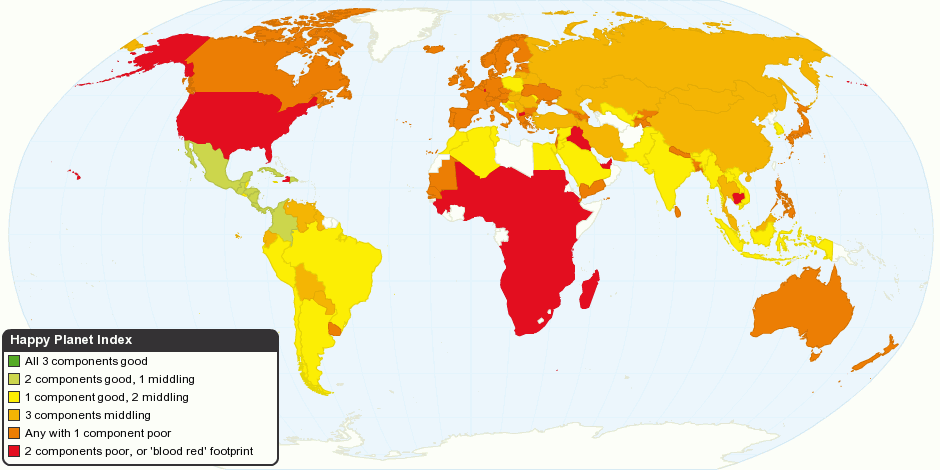This map shows the overall scores from the second global compilation of the Happy Planet Index (HPI). The HPI is an index of human well-being and environmental impact.
The Index doesn't reveal the 'happiest' country in the world. It shows the relative efficiency with which nations convert the planet's natural resources into long and happy lives for their citizens. The nations that top the Index aren't the happiest places in the world, but the nations that score well show that achieving, long, happy lives without over-stretching the planet's resources is possible.
What is Happy Planet Index?
The HPI is an innovative measure that shows the ecological efficiency with which human well-being is delivered around the world. It is the first ever index to combine environmental impact with well-being to measure the environmental efficiency with which country by country, people live long and happy lives.
The HPI shows that around the world, high levels of resource consumption do not reliably produce high levels of well-being, and that it is possible to produce high well-being without excessive consumption of the Earth's resources. It also reveals that there are different routes to achieving comparable levels of well-being. The model followed by the West can provide widespread longevity and variable life satisfaction, but it does so only at a vast and ultimately counter-productive cost in terms of resource consumption.
How is the Happy Planet Index calculated?
The HPI reflects the average years of happy life produced by a given society, nation or group of nations, per unit of planetary resources consumed. Put another way, it represents the efficiency with which countries convert the earth's finite resources into well-being experienced by their citizens.
The Global HPI incorporates three separate components:
- Ecological footprint.
- Life-satisfaction.
- Life expectancy.
Each country's HPI value is a function of its average subjective life satisfaction, life expectancy at birth, and ecological footprint per capita. Conceptually the HPI is straightforward. It is an efficiency measure: well-being delivered per unit of environmental impact. Most of the life satisfaction data is taken from the World Values Survey and World Database of Happiness, but some is drawn from other surveys, and some is estimated using statistical regression techniques.
Note
- Mouse over each country to see its name and HPI score in figures.
- Country's colour and its HPI score are not directly related (Colour coded by country based on its traffic light score on each of the three components of the Index).
16 years ago

